We may receive a commission when you use our affiliate links. However, this does not impact our recommendations.
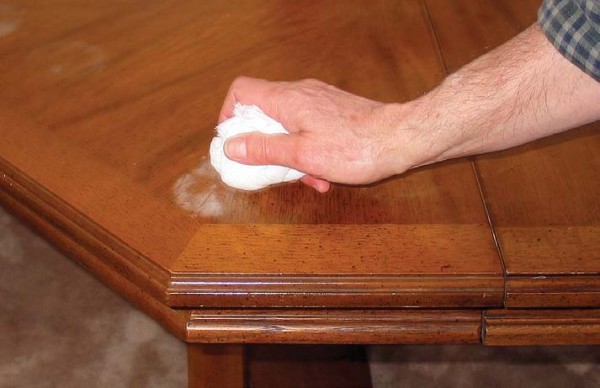
One method of removing white water marks (rings) is to wipe over with a lightly alcohol-dampened cloth. You’ll have more control if you fold the cloth into a pad, like a French-polish pad. Use only enough alcohol so you leave an evaporating trail resembling a comets tail as you wipe.
A wet drinking glass can make an ugly white or dark ring on your furniture. Here’s how to fix the damage.
by Bob Flexner
Watermarks occur on furniture with finishes that have aged. These marks, also called water rings when they’re round in shape, rarely occur in newly applied film-building finishes, even those such as shellac that have reputations for weak water resistance.
There are two types of watermarks: light and dark. Light marks are milky-white and are caused by moisture getting into the finish and creating voids that interfere with the finish’s transparency. Dark marks are brown or black and are caused by water and metal residue penetrating through cracks in the finish and getting into the wood.
Both types are easy to remove but the finish usually has to be stripped before removing dark watermarks. Don’t confuse heat damage with light watermarks or ink stains with dark watermarks – both are usually very difficult to remove.
Light Watermarks
To remove milky-white watermarks, you need either to consolidate the finish (eliminate the voids) to the point that the transparency is reestablished or cut the film back to below the damage. Success is not predictable, but in general, a white watermark is easier to remove in the following circumstances: 1) the finish is newer, 2) the shorter the time the watermark has been in the finish, and 3) the shallower the damage goes into the finish.
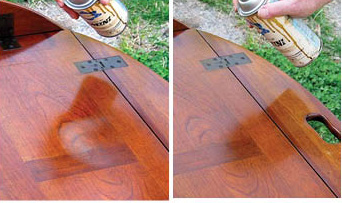
For lacquer finishes, spraying a light mist of “blush” eliminator (butyl Cellosolve) is very effective for removing light water damage. My friend took his table out of his vehicle and set it on the grass. Within a minute or two I had removed the white mark with my “magic” aerosol.
Here are the best ways to remove milky-white watermarks, arranged in order from the least damaging (and generally least effective) to the potentially most damaging.
• Apply an oily substance, such as furniture polish, petroleum jelly or mayonnaise, to the damaged area and allow the liquid or gel to remain overnight. The oil will often restore some of the transparency (by filling some of the microscopic voids) but seldom all of it.
• Heat the finish with a blow dryer or heat gun to soften the finish so it consolidates.
This may restore some of the transparency if you get the temperature just right , but if you get the finish too hot, it will blister. Avoid getting the finish any hotter than is comfortable to touch.
• Dampen a cloth with denatured alcohol and wipe gently over the damaged area. The trick is to dampen the cloth just enough so it leaves the appearance of a comet’s tail of evaporating alcohol trailing as you wipe. (You can practice by wiping across a more resistant surface such as polyurethane or plastic laminate.)
If you get the cloth too wet, the alcohol may soften the finish too much and dull the sheen or smear the finish. This is especially likely if the finish is shellac (used on most furniture finished before the 1930s), but this technique is most effective on shellac.
• Spray a light mist from an aerosol “blush” eliminator over the water damage. The solvent is butyl Cellosolve, which will dissolve lacquer and restore the transparency. Be very careful to avoid too wet a spray or it could damage the finish.
These aerosols are sold to professionals. You might find one at a distributor that caters to the professional trade, or you could spray a mist of lacquer retarder if you have a spray gun and can get it to the furniture or the furniture to it.
• Cut through the damage by rubbing with a mild abrasive such as toothpaste, or with rottenstone (a very fine abrasive powder available at most paint stores) mixed with a light oil. Fine #0000 steel wool lubricated with a light oil, such as mineral oil, is more effective because it cuts faster, but steel wool will leave noticeable scratches in the surface. Use steel wool only as a last resort.
Rub the damaged area until the water damage is gone, being careful not to rub through the finish. Then, if the sheen is different from the surrounding area, even it by rubbing the entire surface with an abrasive that produces the sheen you want.
• French polish over the damaged area using padding lacquer, another product sold to professionals. The lacquer-thinner solvent in the padding lacquer will soften the finish (the same as if it were wiped or sprayed on separately) and often clear up the damage. It may be necessary to continue polishing the entire surface to get an even sheen.
This technique works fairly well on surfaces in good condition, but it is risky on crazed or deteriorated surfaces. If the watermark doesn’t come out entirely with your initial application, you will seal in the remaining milky whiteness and make removing it more difficult.
If you have no experience removing milky-white watermarks, I recommend you try wiping with an alcohol-dampened cloth or rubbing with an abrasive. Both techniques are usually effective and the risk of serious damage is less.
Dark Watermarks
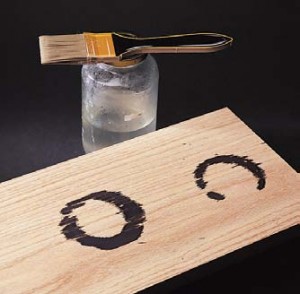
To remove dark water stains, you’ll usually have to remove the finish first. Then dissolve some oxalic acid crystals to a saturated solution in hot water.
The easiest and least damaging way to remove dark watermarks is to bleach them out of the wood with oxalic-acid wood bleach. This chemical is available in crystal form at pharmacies and at many paint and hardware stores. Don’t confuse this bleach with household bleach, which removes dye, or with two-part bleach, which takes the natural color out of the wood.
Dissolve some oxalic-acid crystals at a ratio of one ounce to one quart of warm water or, to make it easier, just make a saturated solution by adding the crystals to hot water until no more will dissolve.
A glass jar makes a good container, but leave some air space at the top for gases to collect if you store the solution. Never use a metal container, because it rusts.
Brush a wet coat of the solution over the entire surface, not just over the stains, to keep the color even. If you are working on mahogany or cherry, which usually darken as they age, the oxalic acid may lighten the wood back to its original color.
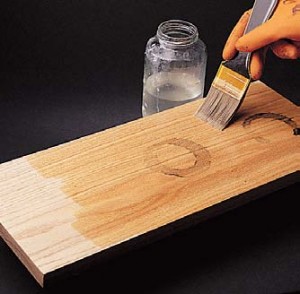
Brush on the oxalic acid solution over the entire surface. The dark marks will begin to fade immediately, though it will take a little longer for them to disappear entirely.
Let the oxalic acid dry, then wash the crystals off the wood with a hose or well-soaked sponge or cloth. Don’t brush the crystals into the air because they will cause you to choke if you breathe them in.
Usually, one application will remove the black marks, but you can always try a second if the first doesn’t work. Often, a light tan mark will remain after the black has been removed. It can be removed easily with a light sanding.
CAUTION: Oxalic acid is toxic, capable of causing severe skin and respiratory problems. Wear gloves and goggles when using it, and don’t generate airborne dust.
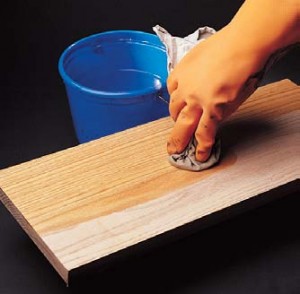
When the wood dries, the crystals will reappear. Wash them off with a hose or wet rag or sponge. Never brush the crystals off the surface because they are toxic to breathe.
Oil Finishes
Dark watermarks occur easily in oil finishes because they’re too thin to be effective against water penetration. Milky-white watermarks are very rare, however. The lighter watermarks you sometimes see in oil finishes are almost always caused by random light reflection from raised grain telegraphing through the thin oil.
To repair light, raised-grain watermarks in oil finishes, level the raised grain with sandpaper or steel wool and apply more oil finish. Abrade the damaged area as little as possible to avoid lightening the color of the wood. PWM
Here are some supplies and tools we find essential in our everyday work around the shop. We may receive a commission from sales referred by our links; however, we have carefully selected these products for their usefulness and quality.








